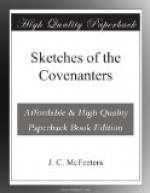1. Give an account of the First Covenant.
2. Describe the First General Assembly.
3. What was the value of the First Book of Discipline?
4. Describe the founding of Public Schools in Scotland.
5. When was the First Reformation at its climax?
6. How should the success of the fathers inspire us?
VI.
Scotland’s national covenant.—A.D. 1581.
During the sixties of the Sixteenth century, the Presbyterian Church had her beautiful summer. The winter seemed to be past and the storms over and gone; the time of the singing of birds had come.
Hitherto the Church had been as a lily among thorns: now instead of thorns were fir trees, and instead of briers, myrtle trees, to the glory of the Lord, who is wonderful in counsel and excellent in working.
Among the matchless sayings of Jesus, one specific word resounds through all the ages and falls upon listening ears like thunder from heaven: “Watch”. Eternal vigilance is the price of liberty, the price of purity, the price of honor, the price of every thing worth having. The young Church, vigorous, victorious, and enthusiastic, seems to have been off her guard at a critical moment and while she slept the enemy sowed tares among the wheat.
The regent, the person who was acting as king while the coming king was a child, called a convention of ministers and others who favored the king’s supremacy over the Church. The convention at his dictation introduced Prelacy. This occurred on January 12, 1572, a dark day for Scotland.
Prelacy is little else than Popery modified; Popery in another dress, trained and taught to speak a softer dialect. The power of Popery had been broken, but the residuum still remained, and now there appeared “the strange heterogeneous compound of Popery, Prelacy, and Presbyterianism” in the Church.
The Church awoke to find herself in the grasp of a horrible octopus, from which she did not escape for three generations, and only then at the loss of much precious blood.
The first effort of the Church, when awakened to her real condition, was to control the bishops that had come into her ministry, and whom she was powerless to remove. The next step was to attempt their removal, on the ground that the office of the bishop was unscriptural. Difficulties rapidly increased; opposing forces were daily growing stronger; the Civil government was against the Church; the regent, Scotland’s chief ruler, bent all his energies in the defence of the bishops. From whence shall light and deliverance now come? Listen to the words that seem to be on ten thousand lips: “The Covenants; the Covenants shall be Scotland’s reviving!” “The Covenants” now became the watchword of the faithful. A wave of hopefulness and enthusiasm spread over the Church; gladness wreathed the faces that had gathered blackness, and strength throbbed in hearts that were faint.




